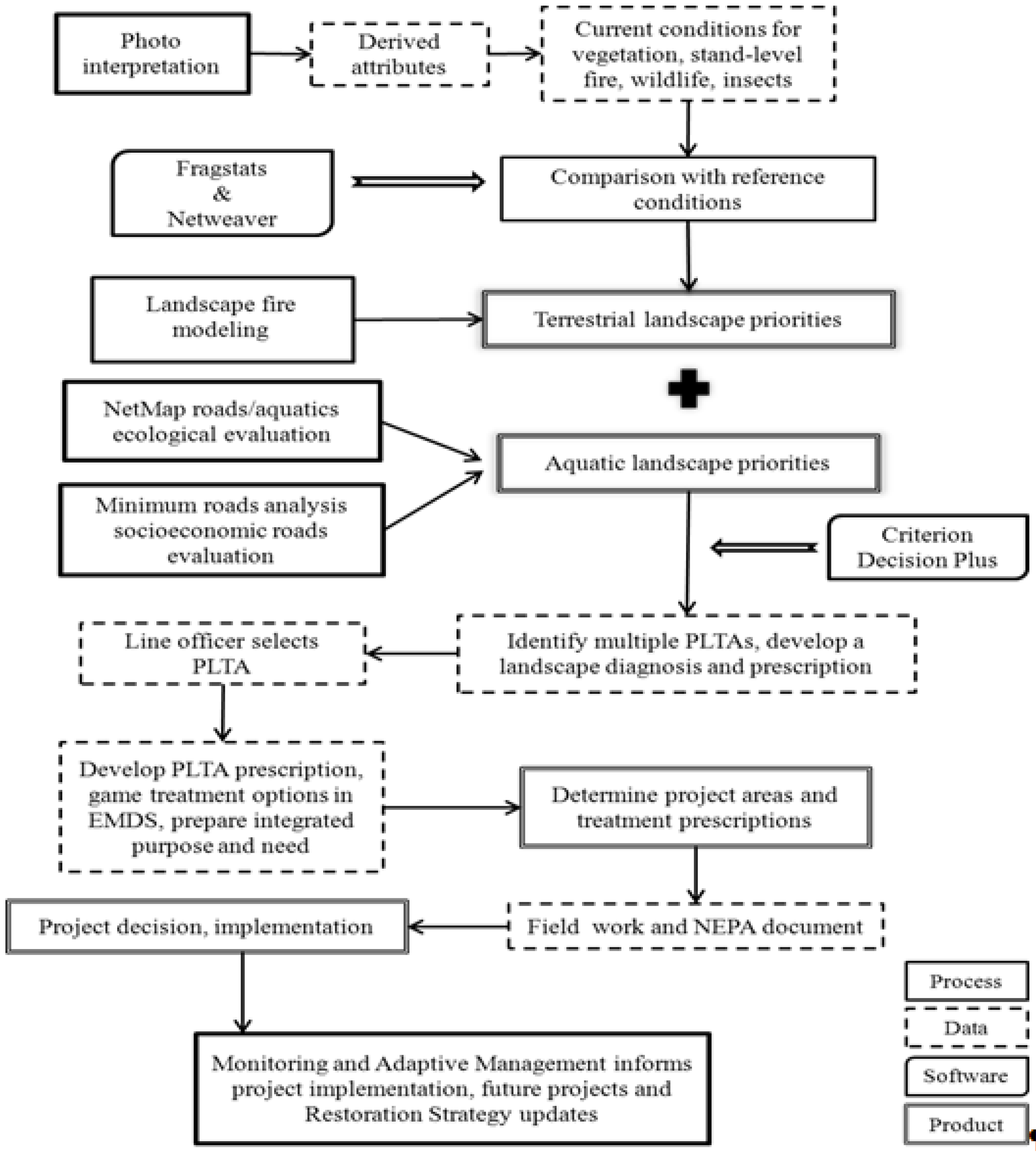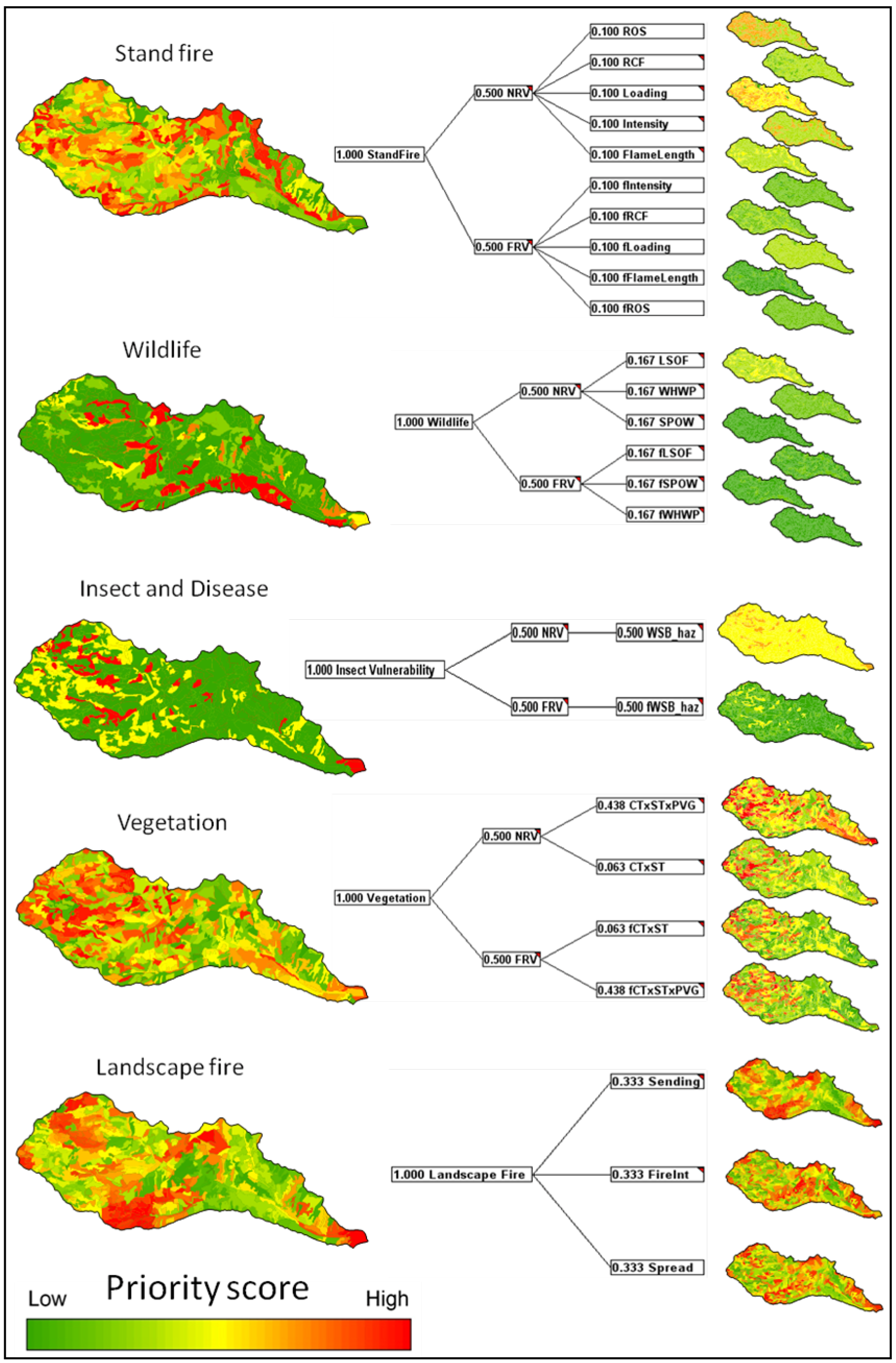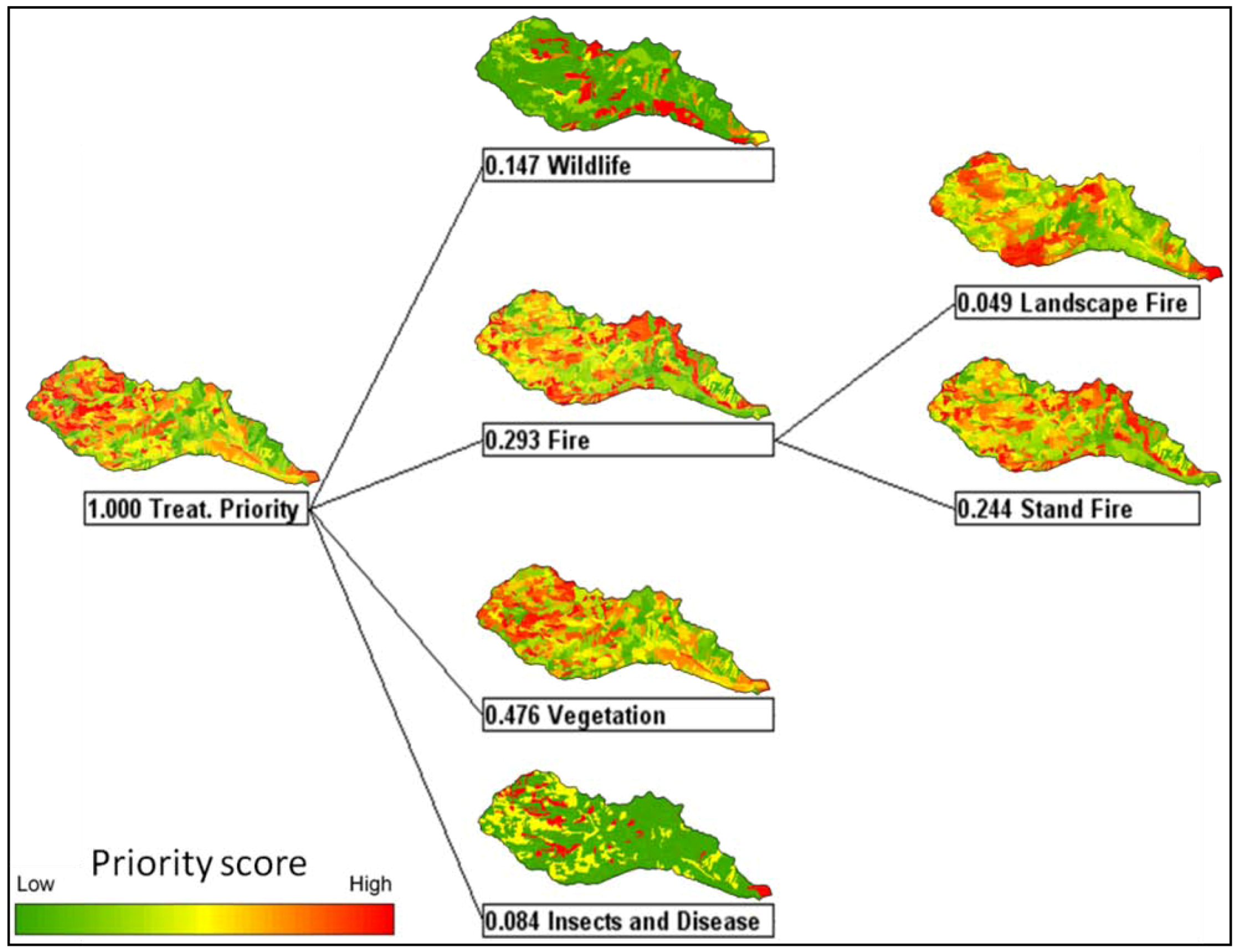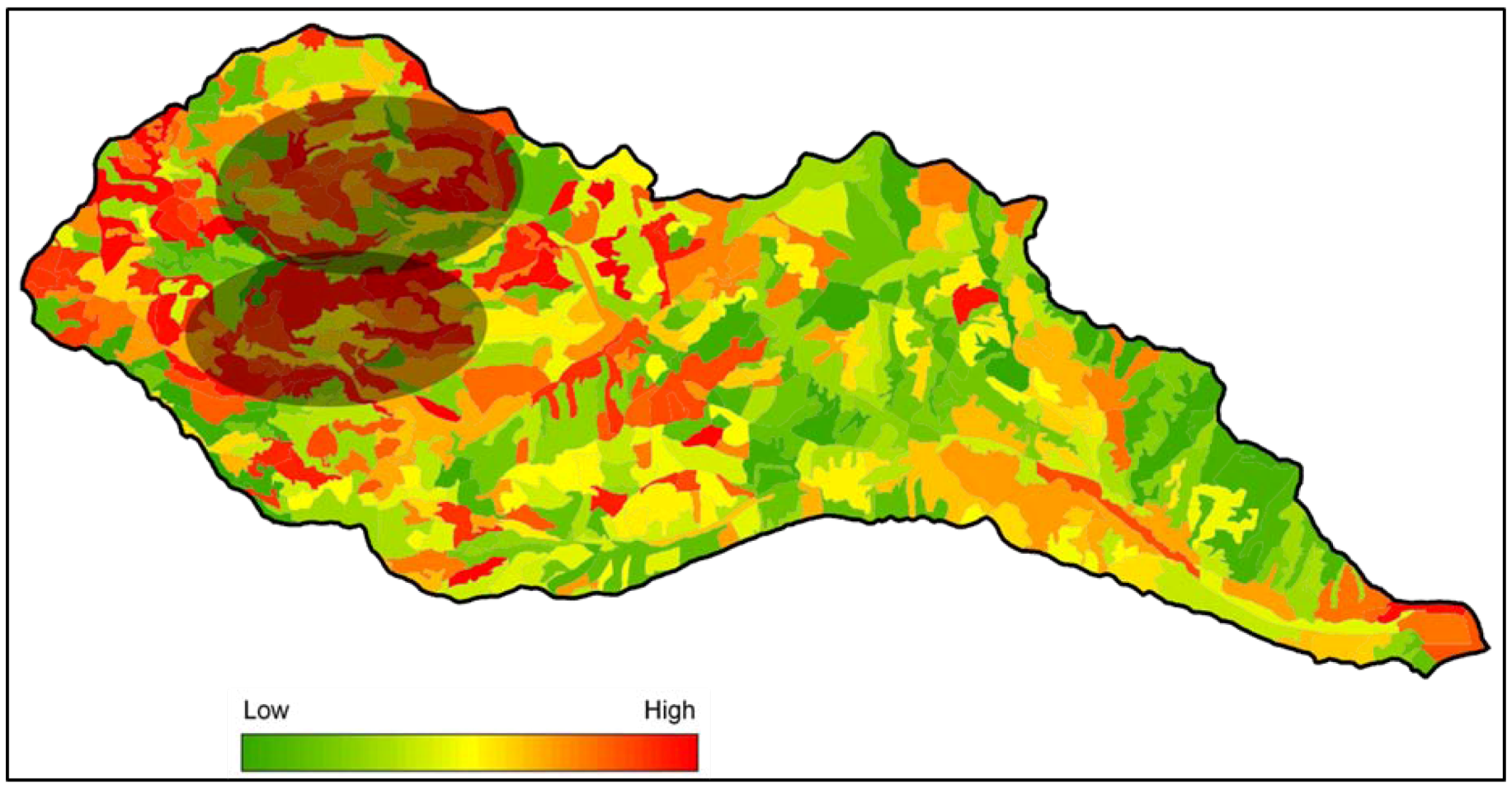Landscape Evaluation for Restoration Planning on the Okanogan-Wenatchee National Forest, USA
Abstract
:List of Acronyms
| AHP | Analytic Hierarchy Process |
| CDP | Criterium Decision Plus |
| CT x SC | Combined cover type and structural class feature |
| DEM | Digital Elevation Model |
| DSS | Decision Support System |
| EMDS | Ecosystem Management Decision Support (system) |
| ESR | Ecological Subregion |
| FRV | Future Range of Variation |
| LSOF | Late-Successional Old Forest |
| NRV | Natural range of Variation |
| PLTA | Potential Landscape Treatment Area |
| PVG x CT x SC | Combined Potential Vegetation Type, Cover Type, and Structural Class Feature |
| RCF | Risk of Crown Fire |
| ROS | Rate of Spread |
| RV | Reference Variation |
| SMART | Simple Multi-Attribute Rating Technique |
| SPOW | Spotted owl |
| WSBW | Western Spruce Budworm |
Definition of Terms
| Integrity | A landscape has integrity when its ecosystems are fully functional, with all of their biotic and abiotic processes intact. |
| Sustainability | Conditions that support native species, ecosystem services, and ecological processes are sustainable when influences on them have not resulted in significant depletion or permanent damage. |
| Restoration | The applied practice of renewing degraded and damaged landscapes, habitats and ecosystems with active human intervention. |
| Resilience | The inherent capacity of a landscape or ecosystem to maintain its basic structure and organization in the face of disturbances, both common and rare. |
Summary
1. Introduction
1.1. Background
1.2. Overview of the Ecosystem Management Decision Support (EMDS) System
1.3. Examples of Landscape Evaluations Using EMDS
1.4. Study Objectives
2. Materials and Methods
2.1. Overview of the Strategy
- Step 1—determine the landscape evaluation area,
- Step 2—evaluate landscape patterns and departures,
- Step 3—determine landscape and patch scale fire danger,
- Step 4—identify key wildlife habitat trends and restoration opportunities,
- Step 5—identify aquatic/road interactions,
- Step 6—evaluate the existing road network,
- Step 7—identify proposed landscape treatment areas (PLTAs), and
- Step 8—refine PLTAs and integrate findings from steps 2–6 into landscape restoration prescriptions.
2.2. Foundations of the Current Study
- (1)
- A theoretical basis for hierarchical patch dynamics in landscapes (Section 1);
- (2)
- Tool development work for evaluating departures in landscape-level spatial patterns of vegetation with respect to reference variation (NRV, also known as RV), based on hierarchical patch dynamics theory (Section 2); and
- (3)
- An approach to analyzing potential vegetation impacts associated with climate change, based on the concept of reference conditions for analogue climate conditions (Section 3).
2.3. Determining the Landscape Evaluation Area

2.4. Project Area

2.5. Evaluating Landscape Vegetation Patterns and Departures
Evaluating Landscape Vulnerability to the Western Spruce Budworm
2.6. Determining Patch and Landscape Scale Fire Danger
2.7. Identifying Wildlife Habitats and Restoration Opportunities for Focal Species
2.8. Evaluating Aquatic Ecosystem and Road Interactions
2.9. Landscape Analysis and Planning in the EMDS System
2.9.1. Overview of Project Workflow

2.9.2. Logic Processing to Assess Departure

2.9.3. Decision Models to Prioritize Forest Patches for Restoration Treatment
3. Results
3.1. Departure Analyses
3.2. Identifying Priority Treatment Areas


3.3. Benefits of Using the EMDS Decision Support Application
3.3.1. Multi-Resource Planning on an Equal Footing
3.3.2. Integration of Resource Values and Conditions
3.3.3. Transparency of Evaluations
3.3.4. Conserving More Rather Than Fewer Options
4. Discussion and Conclusions
4.1. The Selected Project Alternative
- (1)
- Development of several projects in the western half of the subwatershed that reduced vulnerability to wildfires and budworm defoliation, improved vegetation resilience to climatic warming, and decreased fragmentation by increasing patch sizes.
- a.
- These projects emphasized restoring stronger topographic controls on species composition, tree density, and fuelbeds, by tailoring treated patches to north and south aspects and their inherent size distribution.
- b.
- Southerly aspects were thinned to lower stocking levels where the largest western larch and occasional Douglas-fir were favored, and where worst Douglas-fir dwarf mistletoe (Arceuthobium douglasii) infested trees were removed. Surface fuels and fuel ladders were also reduced by prescribed burning.
- c.
- Understory thinning was accomplished using variable retention methods like those described by Larsen and Churchill [61], and Churchill etal. [62]. The resulting patch conditions exhibited a fine scale heterogeneity that included uneven spacing of individual trees and variable sized tree clumps, with variably sized gaps in between them. This was an example of fine scale heterogeneity within patches being incorporated among meso-scale patches.
- d.
- Northerly aspects were allowed to carry higher stocking density and more layered canopy conditions in favor of maintaining spotted owl habitat.
- e.
- Surface fuels treatments were prescribed outside of but adjacent to a number of the best identified spotted owl habitats to increase the likelihood of their persistence in the event of wildfire.
- f.
- White-headed woodpecker habitats were favored on southerly slopes at the forest and woodland ecotone, and on drier ponderosa pine sites, by maintaining large ponderosa pine trees and snags, and by recruiting more of the same for the future. Future stands will become park-like ponderosa pine, old forest single story patches.
- g.
- The project was accomplished without harvesting large and old trees, in order to increase the amount of future old forest and late-successional habitat, and the abundance of future large snags and down logs, which the project identified were already in short supply.
- (2)
- Development of several prescribed burning projects in the eastern half of the subwatershed that reduced vulnerability to wildfires and reduced crown fire hazard in favor of protecting downstream WUI conditions with high certainty.
- h.
- Burn prescriptions were applied over several hundred hectares, especially on southerly aspects, breaking up continuous surface fuel beds, and favoring retention of the largest fire tolerant ponderosa pine.
- i.
- Topography was used to intuitively tailor treated areas.
4.2. What Worked Well?
4.3. What Could Be Improved?
4.4. Research Opportunities
4.5. A Low Cost Alternative to EMDS?
4.6. Conclusions
Supplementary Material
Acknowledgments
Conflict of Interest
References
- Pyne, S.J. Fire in America: A Cultural History of Wildland and Rural Fire; University of Washington Press: Seattle, WA, USA, 1982; p. 680. [Google Scholar]
- Sauer, C.O. Sixteenth Century North America: The Land and the People as Seen by the Europeans; University of California Press: Berkeley, CA, USA, 1971; p. 19. [Google Scholar]
- White, R. It’s Your Misfortune and None of My Own: A New History of the American West; University of Oklahoma Press: Norman, OK, USA, 1991; p. 644. [Google Scholar]
- White, R. Discovering nature in North America. J. Am. Hist. 1992, 79, 874–891. [Google Scholar] [CrossRef]
- White, R. Indian Land Use and Environmental Change. In Indians, Fire, and the Land in the Pacific Northwest; Boyd, R., Ed.; Oregon State University Press: Corvallis, OR, USA, 1999; pp. 36–49. [Google Scholar]
- Robbins, W.G. Colony and Empire: The Capitalist Transformation of the American West; University Press of Kansas: Lawrence, KS, USA, 1994; p. 255. [Google Scholar]
- Robbins, W.G. Landscapes of Promise: The Oregon Story,1800–1940; University of Washington Press: Seattle, WA, USA, 1997; p. 392. [Google Scholar]
- Robbins, W.G. Landscape and Environment: Ecological Change in the Intermontane Northwest. In Indians, Fire, and the Land in the Pacific Northwest; Boyd, R., Ed.; Oregon State University Press: Corvallis, OR, USA, 1999; pp. 219–237. [Google Scholar]
- Hessburg, P.F.; Agee, J.K. An environmental narrative of Inland Northwest U.S. forests 1800–2000. For. Ecol. Manag. 2003, 178, 23–59. [Google Scholar] [CrossRef]
- Langston, N. Forest Dreams, Forest Nightmares: The Paradox of Old Growth in the Inland Northwest; University of Washington Press: Seattle, WA, USA, 1995; p. 368. [Google Scholar]
- Van Wagtendonk, J.W. The history and evolution of wildland fire use. Fire Ecol. 2007, 3, 3–17. [Google Scholar] [CrossRef]
- Hessburg, P.F.; Mitchell, R.G.; Filip, G.M. Historical and Current Roles of Insects and Pathogens in Eastern Oregon and Washington Forested Landscapes; Gen. Tech. Rep. PNW-GTR-327; U.S. Department of Agriculture, Forest Service, Pacific Northwest Research Station: Portland, OR, USA, 1994; p. 72.
- Hummel, S.; Agee, J.K. Western spruce budworm defoliation effects on forest structure and potential fire behavior. Northwest Sci. 2003, 77, 159–169. [Google Scholar]
- Hessburg, P.F.; Agee, J.K.; Franklin, J.F. Dry forests and wildland fires of the inland Northwest USA: Contrasting the landscape ecology of the pre-settlement and modern eras. For. Ecol. Manag. 2005, 211, 117–139. [Google Scholar] [CrossRef]
- McKenzie, D.; Gedalof, Z.; Peterson, D.L.; Mote, P. Climatic change, wildfire, and conservation. Cons. Bio. 2004, 18, 890–902. [Google Scholar] [CrossRef]
- Westerling, A.L.; Swetnam, T.W. Interannual and decadal drought and wildfire in the western United States. EOS Trans. AGU 2003, 84, 554–555. [Google Scholar]
- Westerling, A.L.; Hidalgo, H.G.; Cayan, D.R.; Swetnam, T.W. Warming and earlier spring increase western U.S. forest wildfire activity. Science 2006, 313, 940–943. [Google Scholar]
- Moritz, M.A.; Hessburg, P.F.; Povak, N.A. Native Fire Regimes and Landscape Resilience. In The Landscape Ecology of Fire; McKenzie, D., Miller, C., Falk, D.A., Eds.; Springer: New York, NY, USA, 2011; pp. 51–86. [Google Scholar]
- Hessburg, P.F.; Smith, B.G.; Salter, R.B. Detecting change in forest spatial patterns. Ecol. Appl. 1999, 9, 1232–1252. [Google Scholar] [CrossRef]
- Hessburg, P.F.; Smith, B.G.; Kreiter, S.D.; Miller, C.A.; Salter, R.B.; McNicholl, C.H.; Hann, W.J. Historical and Current Forest and Range Landscapes in the Interior Columbia River Basin and Portions of the Klamath and Great Basins: Part I: Linking Vegetation Patterns and Landscape Vulnerability to Potential Insect and Pathogen Disturbances; Gen. Tech. Rep. PNW-GTR-458; U.S. Department of Agriculture, Forest Service, Pacific Northwest Research Station: Portland, OR, USA, 1999; p. 357.
- Hessburg, P.F.; Smith, B.G.; Salter, R.B. Using Natural Variation Estimates to Detect Ecologically Important Change in Forest Spatial Patterns: A Case Study of the Eastern Washington Cascades; PNW Res. Pap. PNW-RP-514; U.S. Department of Agriculture, Forest Service, Pacific Northwest Research Station: Portland, OR, USA, 1999; p. 65.
- Hessburg, P.F.; Smith, B.G.; Salter, R.B.; Ottmar, R.D.; Alvarado, E. Recent changes (1930’s–1990’s) in spatial patterns of interior northwest forests, USA. For. Ecol. Manag. 2000, 136, 53–83. [Google Scholar] [CrossRef]
- Millar, C.I.; Stephenson, N.L.; Stephens, S.L. Climate change and forests of the future: Managing in the face of uncertainty. Ecol. Appl. 2007, 17, 2145–2151. [Google Scholar] [CrossRef]
- Stephens, S.L.; Millar, C.I.; Collins, B.M. Operational approaches to managing forests of the future in Mediterranean regions within a context of changing climates. Environ. Res. Letters 2010, 5, 024003. [Google Scholar] [CrossRef]
- Reynolds, K.M.; Rodriguez, S.; Bevans, K. User Guide for the Ecosystem Management Decision Support System, Version 3.0; Environmental Systems Research Institute: Redlands, CA, USA, 2003; p. 89. [Google Scholar]
- Miller, B.J.; Saunders, M.C. The NetWeaver Reference Manual; Pennsylvania State University: College Park, PA, USA, 2002; p. 55. [Google Scholar]
- Halpern, D.E. Thought and Knowledge: An Introduction to Critical Thinking; LawrenceErlbaum Associates: Hillsdale, NJ, USA, 1989; p. 517. [Google Scholar]
- Saaty, T.L. Multicriteria Decision Making: The Analytical Hierarchy Process; RWS Publications: Pittsburgh, PA, USA, 1992; p. 321. [Google Scholar]
- Saaty, T.L. Fundamentals of Decision Making and Priority Theory with the Analytical Hierarchy Process; RWS Publications: Pittsburgh, PA, USA, 1994; p. 527. [Google Scholar]
- Edwards, W. How to use multi-attribute utility measurement for social decision making. IEEE Trans. Syst. Man Cybern. Syst. Hum. 1977, 7, 326–340. [Google Scholar] [CrossRef]
- Edwards, W.; Newman, J.R. Multi-Attribute Evaluation; Sage: Beverly Hills, CA, USA, 1982; p. 336. [Google Scholar]
- Stolle, L.; Lingnau, C.; Arce, J.E. Mapeamento da Fragilidade Ambiental em Areas de Plantios Florestais. In Anais XIII Simpósio Brasileiro de Sensoriamento Remoto (in Portuguese), Florianópolis, Brasil, 21–26 April 2007; INPE: Florianópolis, Brazil, 2007; pp. 1871–1873. [Google Scholar]
- Girvetz, E.; Shilling, F. Decision support for road system analysis and modification on the Tahoe National Forest. Environ. Manag. 2003, 32, 218–233. [Google Scholar] [CrossRef]
- Janssen, R.; Goosen, H.; Verhoeven, M.L.; Verhoeven, J.T.A.; Omtzigt, A.Q.A.; Maltby, E. Decision support for integrated wetland management. Environ. Model. Softw. 2005, 30, 215–229. [Google Scholar]
- Wang, J.; Chen, J.; Ju, W.; Li, M. IA-SDSS: A GIS-based land use decision support system with consideration of carbon sequestration. Environ. Model. Softw. 2010, 25, 539–553. [Google Scholar] [CrossRef]
- Staus, N.L.; Strittholt, J.R.; Dellasala, D.A. Evaluating areas of high conservation value in Western Oregon with a decision-support model. Cons. Bio. 2010, 24, 711–720. [Google Scholar] [CrossRef]
- USDI, Final Draft Recovery Plan for the Northern Spotted Owl; U.S. Department of the Interior: Washington, DC, USA, 1992; Volumes 1 and 2.
- USDA, Record of Decision for the Amendments to Forest Service and BLM Planning Documents within the Range of the Northern Spotted Owl and Standards and Guidelines for Management of Habitat for Late-Successional and Old-Growth Forest within the Range of the Northern Spotted Owl; U.S. Department of Agriculture, Forest Service: Portland, OR, USA, 1994.
- ROD, Record of Decision for Amendments to Forest Service and Bureau of Land Management Planning Documents within the Range of the Northern Spotted Owl; GPO 1994–589–111/0001; U.S. Government Printing Office, Region No. 10: Washington, DC, USA, 1994.
- White, M.D.; Heilman, G.E., Jr.; Stallcup, J.E. Science Assessment for the Sierra Checkerboard Initiative; Conservation Biology Institute: Encinitas, CA, USA, 2005. [Google Scholar]
- USDA Forest Service (USDA-FS). The Okanogan-Wenatchee National Forest Restoration Strategy: Adaptive ecosystem management to restore landscape resiliency. 2010. Available online: http://www.fs.fed.us/r6/wenatchee/forest-restoration/ (accessed on 12 January 2011).
- Reynolds, K.M.; Hessburg, P.F. Decision support for integrated landscape evaluation and restoration planning. For. Ecol. Manag. 2005, 207, 263–278. [Google Scholar] [CrossRef]
- Lehmkuhl, J.F.; Raphael, M.G. Habitat patterns around northern spotted owl locations on the Olympic Peninsula Washington. J. Wildl. Manag. 1993, 57, 302–315. [Google Scholar] [CrossRef]
- Ager, A.A.; Finney, M.A.; Kerns, B.K.; Maffei, H. Modeling wildfire risk to northern spotted owl (Strix occidentalis caurina) habitat in central Oregon, USA. For. Ecol. Manag. 2007, 246, 45–56. [Google Scholar] [CrossRef]
- Gaines, W.L.; Singleton, P.H.; Ross, R.C. Assessing the Cumulative Effects of Linear Recreation Routes on Wildlife Habitats on the Okanogan and Wenatchee National Forests; Gen. Tech. Rep. PNW-GTR-586; U.S. Department of Agriculture, Forest Service, Pacific Northwest Research Station: Portland, OR, USA, 2003; p. 79.
- Reeves, G.H.; Benda, L.E.; Burnett, K.M.; Bisson, P.A.; Sedell, J.R. A disturbance-based ecosystem approach to maintaining and restoring freshwater habitats of evolutionarily significant units of anadromous salmonids in the Pacific Northwest. Am. Fish. Soc. Symp. 1995, 17, 334–349. [Google Scholar]
- Hessburg, P.F.; Salter, R.B.; Richmond, M.B.; Smith, B.G. Ecological subregions of the Interior Columbia Basin, USA. Appl. Veg. Sci. 2000, 3, 163–180. [Google Scholar] [CrossRef]
- Seaber, P.R.; Kapinos, P.F.; Knapp, G.L. Hydrologic Unit Maps; Water-Supply Paper 2294; U.S. Geological Survey: Washington, DC, USA, 1987.
- Gärtner, S.; Reynolds, K.M.; Hessburg, P.F.; Hummel, S.S.; Twery, M. Decision support for evaluating landscape departure and prioritizing forest management activities in a changing environment. For. Ecol. Manag. 2008, 256, 1666–1676. [Google Scholar] [CrossRef]
- Hessburg, P.H.; Smith, B.G.; Miller, C.A.; Kreiter, S.D.; Salter, R.B. Modeling Change in Potential Landscape Vulnerability to Forest Insect and Pathogen Disturbances: Methods for Forested Subwatersheds Sampled in the Midscale Interior Columbia River Basin Assessment; Gen. Tech. Rep. PNW-GTR-454; U.S. Department of Agriculture, Forest Service, Pacific Northwest Research Station: Portland, OR, USA, 1999; p. 56.
- Huff, M.H.; Ottmar, R.D.; Alvarado, E.; Vihnanek, R.E.; Lehmkuhl, J.F.; Hessburg, P.F.; Everett, R.L. Historical and Current Forest Landscapes of Eastern Oregon and Washington. Part II: Linking Vegetation Characteristics to Potential Fire Behavior and Related Smoke Production; Gen. Tech. Rep. PNW-GTR-355; U.S. Department of Agriculture, Forest Service, Pacific Northwest Research Station: Portland, OR, USA, 1995; p. 43.
- Finney, M.A.; Seli, R.C.; McHugh, C.W.; Ager, A.A.; Bahro, B.; Agee, J.K. Simulation of long-term landscape-level fuel treatment effects on large wildfires. Int. J. Wildland Fire 2007, 16, 712–727. [Google Scholar] [CrossRef]
- Forthofer, J.; Shannon, K.; Butler, B. Simulating Diurnally Driven Slope Winds with WindNinja. In Proceedings of 8th Symposium on Fire and Forest Meteorological Society, American Meteorological Society, Kalispell, MT, USA, 13–15 October, 2009.
- Suring, L.H.; Gaines, W.L.; Wales, B.C.; Mellen-Mclean, K.; Begley, J.S.; Mohoric, S. Maintaining populations of terrestrial wildlife through land management planning: A case study. J. Wildl. Manag. 2011, 74, 945–958. [Google Scholar]
- Gaines, W.L.; Begley, J.S.; Wales, B.C.; Suring, L.H.; Mellen-Mclean, K.; Mohoric, S. Terrestrial Species Viability Assessments for the National Forests in Northeastern Washington; Gen. Tech Rep. PNW-GTR-XXX; U.S. Department of Agriculture, Forest Service, Pacific Northwest Research Station: Portland, OR, USA, in press.
- Gaines, W.L.; Harrod, R.J.; Dickinson, J.D.; Lyons, A.L.; Halupka, K. Integration of northern spotted owl habitat and fuels treatments in the eastern Cascades, Washington, USA. For. Ecol. Manag. 2010, 260, 2045–2052. [Google Scholar]
- Benda, L.; Miller, D.; Andras, K.; Bigelow, P.; Reeves, G.; Michael, D. NetMap: A new tool in support of watershed science and resource management. For. Sci. 2007, 53, 206–219. [Google Scholar]
- USDA-NRCS, U.S. Department of Agriculture-Natural Resources Conservation Service. Soil Survey Geographic (SSURGO) Database. 2005. Available online: http://www.ncgc.nrcs.usda.gov/products/datasets/ssurgo/ (accessed on 12 January 2011).
- USDA-NRCS, U.S. Department of Agriculture-Natural Resources Conservation Service. National Geospatial Datasets. 2006. Available online: http://soildatamart.nrcs.usda.gov/ (accessed on 12 January 2011).
- McGarigal, K.; Marks, B.J. FRAGSTATS: Spatial Pattern Analysis Program for Quantifying Landscape Structure; Gen. Tech. Rep. PNW-GTR-351; U.S. Department of Agriculture, Forest Service, Pacific Northwest Research Station: Portland, OR, USA, 1995; p. 122.
- Larson, A.J.; Churchill, D.C. Tree spatial patterns in fire-frequent forests of western North America, including mechanisms of pattern formation and implications for designing fuel reduction and restoration treatments. Forest Ecol. Manag. 2012, 267, 74–92. [Google Scholar] [CrossRef]
- Churchill, D.J.; Larson, A.J.; Dahlgreen, M.C.; Franklin, J.F.; Hessburg, P.F.; Lutz, J.A. Restoring forest resilience: From reference spatial patterns to silvicultural prescriptions and monitoring. Forest Ecol. Manag. 2013, 291, 442–457. [Google Scholar] [CrossRef]
- Gaines, W.L.; Peterson, D.W.; Thomas, C.A.; Harrod, R.J. Adaptations to Climate Change: Colville and Okanogan-Wenatchee National Forests; Gen. Tech. Rep. PNW-GTR-862; U.S. Department of Agriculture, Forest Service, Pacific Northwest Research Station: Portland, OR, USA, 2012; p. 34.
- Keane, R.E.; Parsons, R.; Hessburg, P.F. Estimating historical range and variation of landscape patch dynamics: Limitations of the simulation approach. Ecol. Model. 2002, 151, 29–49. [Google Scholar] [CrossRef]
- Barrett, T.M. Models of Vegetation Change for Landscape Planning: A Comparison of FETM, LANDSUM, SIMPPLLE, and VDDT; Gen. Tech. Rep. RMRS-GTR-76; U.S. Department of Agriculture, Forest Service, Rocky Mountain Research Station: Ogden, UT, USA, 2001; p. 14.
- Wimberly, M.C. Spatial simulation of historical landscape patterns in coastal forests of the Pacific Northwest. Can. J. For. Res. 2002, 32, 1316–1328. [Google Scholar] [CrossRef]
- Mladenoff, D.J. LANDIS and forest landscape models. Ecol. Model. 2004, 180, 7–19. [Google Scholar] [CrossRef]
- Cary, G.J.; Keane, R.E.; Gardner, R.H.; Lavorel, S.; Flannigan, M.D.; Davies, I.D.; Li, C.; Lenihan, J.M.; Rupp, T.S.; Mouillot, F. Comparison of the sensitivity of landscape-fire-succession models to variation in terrain, fuel pattern, climate and weather. Landscape Ecol. 2006, 21, 121–137. [Google Scholar] [CrossRef]
- Price, B.; McAlpine, C.A.; Kutt, A.S.; Phinn, S.R.; Pullar, D.V.; Ludwig, J.A. Continuum or discrete patch landscape models for savanna birds? Towards a pluralistic approach. Ecography 2009, 32, 745–756. [Google Scholar] [CrossRef]
- Woinarski, J.C.Z.; Fisher, A.; Milne, D. Distribution patterns of vertebrates in relation to an extensive rainfall gradient and variation in soil texture in the tropical savannas of the Northern Territory, Australia. J. Trop. Ecol. 1999, 15, 381–398. [Google Scholar] [CrossRef]
- Dunn, A.G.; Majer, J.D. In response to the continuum model for fauna research: A hierarchical, patch-based model of spatial landscape patterns. Oikos 2007, 116, 1413–1418. [Google Scholar] [CrossRef]
- Wiens, J.A. The emerging role of patchiness in conservation biology. In The Ecological Basis of Conservation; Pickett, S.T.A., Ostfeld, R.S., Shachak, M., Likens, G.E., Eds.; Chapman & Hall: New York, NY, USA, 1997; pp. 93–107. [Google Scholar]
- USFWS, Revised Recovery Plan for the Northern Spotted Owl (Strix occidentalis caurina); U.S. Fish and Wildlife Service: Portland, OR, USA, 2011; p. 277.
- USFWS, Endangered and Threatened Wildlife and Plants; Designation of Revised Critical Habitat for the Northern Spotted Owl. Final Rule; 50 CFR, Part 17, FWS–R1–ES–2011–0112; 4500030114, RIN 1018–AX69, Federal Register 77, 233, Tuesday, December 4, 2012, Rules and Regulations; US Government Printing Office: Washington, DC, USA, 2012; pp. 71876–72068.
© 2013 by the authors; licensee MDPI, Basel, Switzerland. This article is an open access article distributed under the terms and conditions of the Creative Commons Attribution license (http://creativecommons.org/licenses/by/3.0/).
Share and Cite
Hessburg, P.F.; Reynolds, K.M.; Salter, R.B.; Dickinson, J.D.; Gaines, W.L.; Harrod, R.J. Landscape Evaluation for Restoration Planning on the Okanogan-Wenatchee National Forest, USA. Sustainability 2013, 5, 805-840. https://doi.org/10.3390/su5030805
Hessburg PF, Reynolds KM, Salter RB, Dickinson JD, Gaines WL, Harrod RJ. Landscape Evaluation for Restoration Planning on the Okanogan-Wenatchee National Forest, USA. Sustainability. 2013; 5(3):805-840. https://doi.org/10.3390/su5030805
Chicago/Turabian StyleHessburg, Paul F., Keith M. Reynolds, R. Brion Salter, James D. Dickinson, William L. Gaines, and Richy J. Harrod. 2013. "Landscape Evaluation for Restoration Planning on the Okanogan-Wenatchee National Forest, USA" Sustainability 5, no. 3: 805-840. https://doi.org/10.3390/su5030805
APA StyleHessburg, P. F., Reynolds, K. M., Salter, R. B., Dickinson, J. D., Gaines, W. L., & Harrod, R. J. (2013). Landscape Evaluation for Restoration Planning on the Okanogan-Wenatchee National Forest, USA. Sustainability, 5(3), 805-840. https://doi.org/10.3390/su5030805






